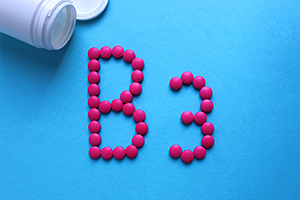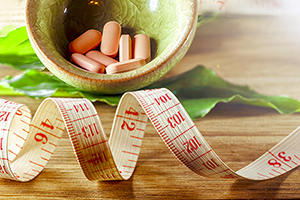



| By Dr. Ronald Hoffman
The vast majority of patients consult me at the Hoffman Center for problems related to overweight. Sometimes these problems are difficult to “fix,” even with the extensive arsenal of weapons in the holistic arsenal available to us, because deep-seated metabolic defects can be challenging to overcome.
But surprisingly, as hard as it is to get patients to lose weight, getting them to gain weight is considerably more difficult.
First, an observation about weight gain: The trick is not just to put on weight, which is relatively easy. The goal of healthy weight augmentation is to put it in the right places: muscle tissue rather than fat depots in the belly, thighs or buttocks.
When confronted by an adult patient desirous of weight gain, I sometimes facetiously suggest that they learn from the secrets of the sumo wrestlers. These highly preened Japanese martial artists follow a strict regimen to achieve the “throw-weight” that enables them to push opponents off the mat. That regimen is the opposite of what helps keep weight down: lots of calories from bowl after bowl of refined white rice, with plenty of caloric beer topped off by rich ice cream, followed by an immediate nap to allow the calories to be assimilated without being burnt off.
Alternatively, underweight persons might try another tried-and-true method for weight gain: dieting. Yes, dieting. Temporary calorie deprivation followed by resumption of normal liberal food intake is a great way to put on weight—ask any yo-yo dieter! It’s as if undernutrition primes the metabolism for more efficient fat accumulation when the famine ends. Unfortunately, our bodies have evolved to cycle between deprivation and surfeit. Tricked into believing that a famine is around the corner, the body hoards calories and stores them as fat as a means of survival. Chronically underweight individuals can sometimes prime their metabolisms for healthy weight gain by “clearing their palate” with a few weeks of light eating before resuming a high-calorie regimen.
Actually, underweight is a frequent complaint of older adults. It’s as if the aging process bifurcates us into two distinct populations of seniors: those who are rotund and those who are frail. As we age, it becomes harder and harder to find individuals who reflect the happy medium of optimal weight.
The process by which we lose healthy body weight is called “sarcopenia,” and it’s estimated that most adults lose 10 percent of their muscle weight every decade after the age of 40. Part of this is the inevitable consequence of decreased exercise due to reduced physical capabilities. Additionally, the absorptive capacity of the GI tract declines with aging. But some weight loss is driven by an age-related decline in “anabolic” hormones such as testosterone, DHEA and growth hormone.
Evaluating levels of DHEA and testosterone, and replacing them where appropriate, are major tools for combating sarcopenia. Concerns remain over potential adverse long-term effects of growth hormone administration in adults.
Sometimes, malabsorption is to blame for inability to optimize weight. Food allergies or inflammatory intestinal conditions can interfere with optimal nutrient absorption. It is not uncommon to find hidden cases of ulcerative colitis or Crohn’s disease in kids who fail to achieve weight and height milestones. Perpetually thin individuals also may be suffering from celiac disease, an often missed condition of gluten intolerance that impairs nutrient uptake.
Short of these overt diseases, many people who can’t gain weight have hidden food allergies. The IgG RAST blood test can effectively pinpoint food intolerances that interfere with proper functioning of the GI tract. In many cases, malabsorption can be deduced from blood tests that measure levels of critical nutrients like iron, B vitamins, minerals such as zinc, and fat-soluble nutrients such as beta carotene, vitamin D, and essential fatty acids. A history of chronic bloating, diarrhea with certain foods such as milk products or fats, pancreatic problems, alcoholism, or intestinal surgery are suggestive of malabsorption. Inability to gain weight also can suggest a chronic parasite infection.
Many drugs tend to slow down metabolism and make patients gain weight, with a few exceptions: Stimulant medications used to treat childhood ADD and hyperactivity tend to reduce appetite and stunt growth. Nutritional support and diet modification may help kids reduce or eliminate their dependency on growth-inhibiting medications.
Of course, serious medical causes of weight loss need to be ruled out with appropriate tests: overactive thyroid (Graves’ disease), certain cancers, serious autoimmune diseases, chronic obstructive pulmonary disease (emphysema) and Alzheimer’s disease are among the many systemic diseases that are heralded by weight loss.
Exercise of the right type plays a critical role in healthy weight gain. In fact, for some perennially underweight individuals, it’s the ONLY way they will gain healthy muscle mass. Notwithstanding the aisles full of muscle-building formulas that entice would-be bodybuilders at health food stores, calories and protein won’t find their way into your muscle cells unless directed there by your exertions.
The right kind of exercise makes a difference. Highly aerobic activities like long-distance running are actually catabolic–they result in net weight loss, and cannibalize muscle tissue from the upper body to support energy output. Strength training with weights or resistance bands is anabolic-repeated stress and incites muscle cells to proliferate. Fewer reps at near-maximal strength (7-10) build muscle size more efficiently than lots of reps of light weights. Those 5 pound dumbbells will help you grow stronger and tone your muscles but scarcely make you into a Schwarzenegger.
Competitive bodybuilders have refined muscle cultivation into an exacting science.
Smoking cessation is imperative for combating weight loss, because cigarettes have an anorectic effect. Surprisingly, caloric soft drinks and sweets sometimes rob people of normal appetite for healthy foods and are the bane of finicky eaters, especially underweight children.
What are the best foods to eat for weight gain? I believe it’s a mistake to sacrifice healthy eating on the altar of weight gain and to consume poor quality fats and refined carbohydrates merely for their caloric value. At the Hoffman Center we urge individuals desirous of weight gain to eat lots of protein (including range-fed red meat and poultry), healthy fats from sources like nuts, olive oil, coconut oil, natural dairy products (if not intolerant) and oily fish, and emphasize more starchy vegetables such as corn, potatoes, beets, tapioca and yams, fruits like bananas and raisins, and easily-assimilated grains such as white rice, millet and buckwheat. And since excess fiber may produce early satiety, we advise underweight patients to lighten up on “fiber-mania” which precludes healthy calories. Healthy shakes may incorporate calorie sources like fresh or frozen fruit, flax oil, coconut milk, organic full-fat yogurt or heavy cream, or unrefined honey.
Though we think of declining estrogen as the hallmark of menopause, it's actually common for…

Up to 12 percent of Americans have ulcers at some point in life. Peptic ulcers…
Gallbladder disease is a modern illness. An estimated 20 million Americans have gallbladder disease. The…

This past week we were regaled with headlines like: High levels of niacin may increase…

March is National Nutrition Month and, needless to say, good nutritious food is essential to…

I recently attended the Integrative Healthcare Symposium (IHS), an annual conference held here in Manhattan. The…

Q&A with Leyla, Part 1: A Nicotine Vaccine

Our virtual voicemail is open 24/7, so there's no need to wait to submit your questions for Dr. Hoffman. Leave a message, and you may hear your question featured on the Intelligent Medicine radio program!